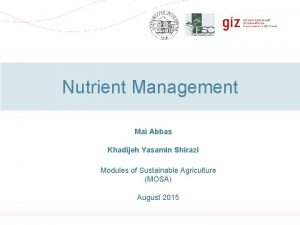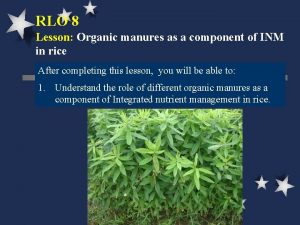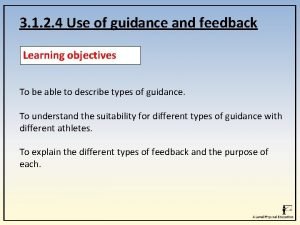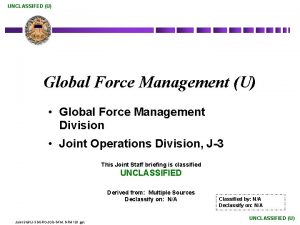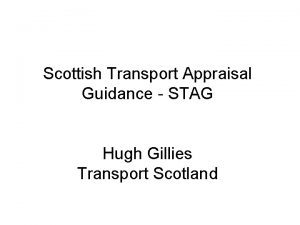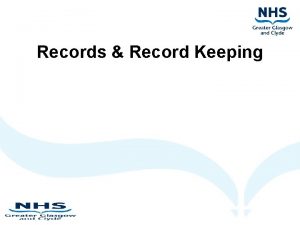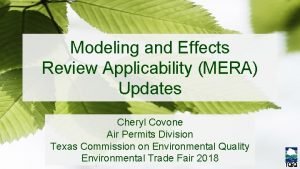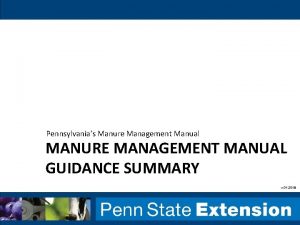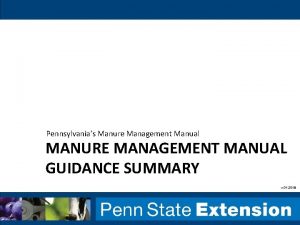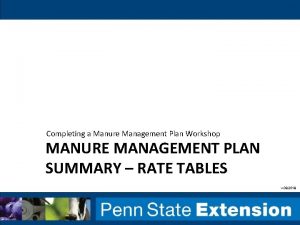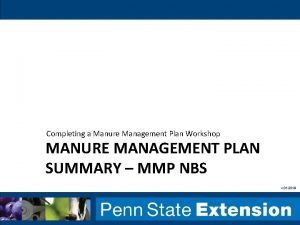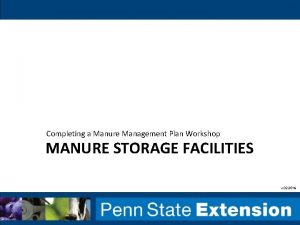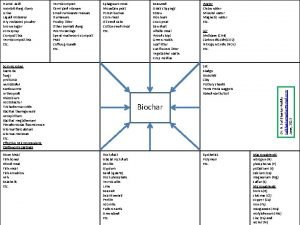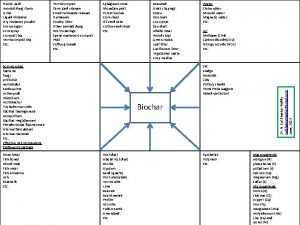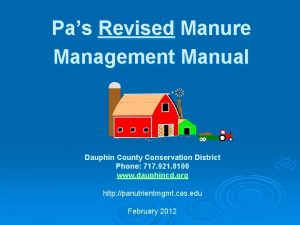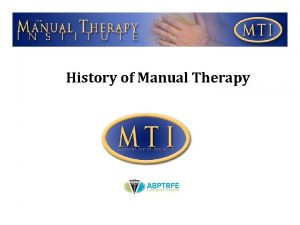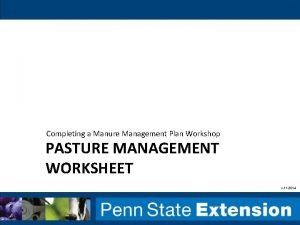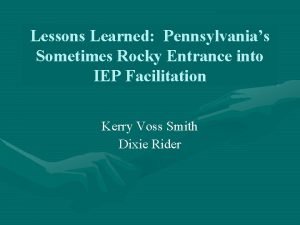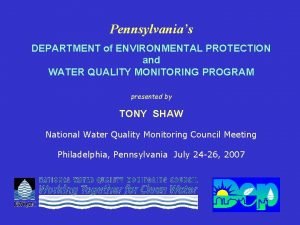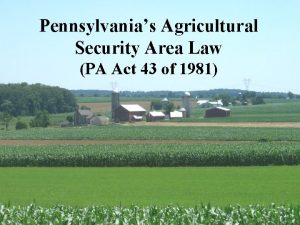Pennsylvanias Manure Management Manual MANURE MANAGEMENT MANUAL GUIDANCE
























- Slides: 24

Pennsylvania’s Manure Management Manual MANURE MANAGEMENT MANUAL GUIDANCE SUMMARY v. 01. 2018

Revised Manure Management Manual • Manure Management Manual for Environmental Protection – Since 1972 • Land Application of Manure Revision – Released October 29, 2011 • Manure Management Plan Guidance

Manure in Pennsylvania • All farms or entities in Pennsylvania that generate or land apply manure – Produce or use – Must meet some type of state requirements • Regardless of size – Includes very small entities • One-horse operations • Regardless of manure origin – Includes operations without livestock or poultry • If manure is spread on the operation • Regardless of type of application – Not limited to mechanical application – Includes direct application by animals on pasture

Animal Operations in Pennsylvania • Concentrated Animal Feeding Operations (CAFOs) – Based on animal numbers and/or animal density – Farms > 1, 000 AEUs, CAOs > 300 AEUs, EPA head numbers • Regulated by PA DEP (for US EPA) – Approved NMP, DEP CAFO permit, certified planner, public access • AOs (23, 190+) Concentrated Animal Operations (CAOs) CAOs (1003+) – High animal density farms > 2, 000 lbs/acre animal density • Act 38 regulated by PA SCC – Approved NMP, certified planner, public access • CAFOs (429+) All Animal Operations (AOs) – All operations generating or utilizing manure • Manure Management Manual regulated by PA DEP – Manure Management Plan State Conservation Commission 2017

Manure Management Plan Requirements • Must be a written plan • Can be developed by the farmer or other non-certified individual • Must use the standard format and worksheets in the MMM – Unless an alternative is approved by DEP • Do not need to be submitted for approval – But must be available onsite to DEP or Conservation District staff on request for inspection • Includes more than manure application rates – – – • Mechanical manure application setbacks Winter manure application Manure storage and stacking areas management Pasture management Animal concentration areas management Records are required to document implementation – Must be kept on the farm

Manure Application Rates • Three approaches may be used to determine manure application rates – MMM Appendix 1 – Manure Application Rate Tables • Easy to use lookup tables which are based on averages and limits – Nutrient Balance Worksheets • Calculations required, but uses farm specific information – Nutrient Balance Worksheets incorporating the PA Phosphorus Index • More flexibility, but requires a authorized planner

MMM Tables P Removal Time & Cost Balance Sheet P Removal MMM Tables N Based Simple-Easy-Inexpensive Balance Sheet N Based Act 38 NMP Complex-Difficult-Expensive Written By Specialist No No Soil Tests No No Yes (< 200 ppm P) Balance Sheet P Index (< 200 ppm P) Yes (Authorized) (Certified) Yes No Yes Soil Test > 200 ppm P Options Manure Analysis Specific Crop Information Application Rates Management Flexibility No No No (based on averages) Yes Lower Very Restrictive No No No Yes (based on averages) Yes (plus manure specific) Higher All Fields (less fields ? ) (N or P) Maximum Flexibility

Step 1: Find the table in the back of the MMM (Appendix 1) for: 1. Rate basis N or P 2. Type of manure Step 2: Find the crop in the table

1. Find the yield at the top 2. Find the application method in the left column 3. Read the rate from the table Corn Silage Yield Groups (ton/A) 17 -21 22 -25 26 -29 Manure Application Rate Adjustment 30 -33 For each 1000 gal/A less than the rate in the table, Manure Fert N apply lbs. N fertilizer gal/A lb/A listed below. Manure gal/A Fert N lb/A Spring Incorporation within 1 day 9000 0 11000 0 14000 0 16000 0 14 Spring Incorporation within 1 week 13000 0 16000 35 16000 65 10 Spring No Incorporation 16000 40 16000 70 16000 130 6 Fall 16000 40 16000 70 16000 130 6 Winter with cover crop 5000 75 5000 105 5000 135 5000 165 11 Winter No cover crop 5000 100 5000 130 5000 160 5000 Manure Application Method • 190 No more than 9000 6 gal/A of liquid manure can be applied in a single application. • Spilt higher rates into multiple applications.

Corn Silage Yield Groups (ton/A) 17 -21 22 -25 26 -29 Manure Application Rate Adjustment 30 -33 For each 1000 gal/A less than the rate in the table, Manure Fert N apply lbs. N fertilizer gal/A lb/A listed below. Manure gal/A Fert N lb/A Spring Incorporation within 1 day 9000 0 11000 0 14000 0 16000 0 14 Spring Incorporation within 1 week 13000 0 16000 35 16000 65 10 Spring No Incorporation 16000 40 16000 70 16000 130 6 Fall 16000 40 16000 70 16000 130 6 Winter with cover crop 5000 75 5000 105 5000 135 5000 165 11 Winter No cover crop 5000 100 5000 130 5000 160 5000 190 6 Manure Application Method • Allowable Rate = 16, 000 gal/A + 70 lb N/A • Planned Rate = 9000 gal/A • Difference = 7000 gal/A x 6 lb N/1000 gal = 42 lb additional fertilizer N required per acre • Total Fertilizer Required = 70 + 42 = 112 lb N/A

Nutrient Balance Sheets (NBS) • Nutrient Balance Sheets may be used instead of the Manure Application Rate Tables • Farm and crop specific – Better utilize manure to meet crop nutrient needs – Reduces need to purchase fertilizer • Nutrient Balance Sheets – Act 38 Nutrient Balance Sheets • Paper or Excel spreadsheet versions • Nutrient Balance Worksheet User Guide – MMP Nutrient Balance Sheets • MMP Balance Sheet User Guide

Manure Application Setbacks • No mechanical manure application within 100 feet of: – Streams, lakes and ponds • During times when water flows in the stream – Existing open sinkholes – Private and public drinking water • Unless public authority requires greater distances • Setback for streams, lakes and ponds can be reduced – These options are not applicable for winter application – Option 1: Within 50 feet of streams, lakes and ponds if related fields: • • Have soil tests current within the last three years Soil test phosphorus (Mehlich 3 -P) levels are less than 200 parts per million (ppm) No-till practices are used When residue is removed, a cover crop must be planted – Option 2: Within 35 feet of streams, lakes and ponds • A permanent vegetated buffer is established and maintained along the water body

Manure Application Setbacks • No mechanical manure application for winter application within 100 feet from an above ground inlet to an agricultural drainage system – Such as inlet pipes to piped outlet terraces – Where surface water flow is toward the above ground inlet • No mechanical manure application within the channel of a non-vegetated concentrated water flow area – Swale, gully or a ditch • Manure application setbacks are required – Regardless of the slope of the land or the ground cover – Only for mechanical application • No setbacks for pastures

Winter Manure Application • Winter is anytime one of the following is true: – December 15 through February 28; or – Anytime the ground is frozen at least 4 inches; or – Anytime that the ground is snow covered • The maximum application rate for the winter season – 5000 gallons per acre of liquid manure – 20 tons per acre of dry non-poultry manure per acre – 3 tons of dry poultry manure per acre • Must have at least 25% crop residue at application time or an established and growing cover crop • Manure may not be applied on fields with slopes greater than 15% – NRCS soil survey slope designations of “A”, “B” or “C” slopes are acceptable for winter application determinations

Pasture Management • All pastures on the farm must be included in the plan • Two pasture management options – Option 1: Grazing plan that meets the requirements of the PA Tech Guide Prescribed Grazing (528) standard (or) – Option 2: Assure that pasture management: • Maintains dense vegetation in the pasture throughout the growing season • Minimizes bare spots • Maintains an average vegetation height across the pasture during the growing season at least 3 inches high • Pastures which are overgrazed and do not meet one of the two management options must: – Implement one of the two options to restore dense vegetation (or) – Designate the pasture an Animal Concentration Area (ACA) • Meet ALL the management requirements for ACAs

Animal Concentration Areas (ACAs) • Also called “Animal Heavy Use Areas” • Barnyards, feedlots, loafing areas, exercise lots or other similar animal congregation areas within pastures that will not maintain dense vegetation • Does not include pastures meeting the pasture requirements • ACAs may exist within pastures – Walkways, feeding areas, watering areas, shade areas – Not considered ACAs if water from or precipitation onto these areas does not result in runoff of manure or sediment to streams, lakes, ponds, or sinkholes

ACA Requirements • Divert clean water flow from upslope fields, driveways, barn roofs, etc. away from the ACA • Direct polluted runoff or allow it to flow from the ACA area into a storage facility or best management practice such as a correctly sized and well maintained vegetative filter strip • Limit animal access to surface waters to only properly implemented livestock crossings – Animals may not have free access to streams adjacent to or within ACAs • Minimize the size of denuded areas such as sacrifice lots • Keep areas where animal congregation areas as far away from water bodies as practical – Relocate movable structures creating animal congregation areas annually where appropriate and practical • Remove manure routinely from ACAs, where practical – Generally four times per year

Manure Storage Management • MMP must assure proper and safe storage of manure and agricultural process wastewater • Liquid or semi-solid manure storage facilities must be evaluated by the farmer monthly – No evidence of overtopping or leakage from the manure storage facility • Maintain a minimum 12 -inch freeboard for all ponds at all times • Maintain a minimum 6 -inch freeboard for all other manure storage facilities at all times – No visible cracking, rodent holes, tree or shrub growth on the berms or other problems with manure storage facilities that would lead to leakage – No visible slope failures, visible deterioration or tears of any liner, or knowledge of any local water pollution issues associated with the storage facility • Monthly documentation required for liquid and semi-solid storages – Not required for solid storages – Written records must be maintained • Liquid or semi-solid manure storage facilities built in the year 2000 and later – Must be designed by a licensed Pennsylvania Professional Engineer – Copy of engineer’s certification that the storage facility was built according to the appropriate standards must be maintained

In-Field Manure Stacking • Requirements for manure stacking at the farmstead – Manure stacking in the farmstead must use an improved stacking pad or covered area • Requirements for temporary stacking in non-farmstead areas such as crop fields: – Keep at least 100 feet from streams, lakes, ponds, open sinkholes, drinking water wells – Divert upslope water away from the stacking area – Place on areas with less than 8% slope – Manure must be dry enough to allow for stacking at least 4 feet in height – Stack must be covered if it will be in place longer than 120 days – In-field stacking areas should not be in the same location each year – Cannot be placed within an area of concentrated water flow • Swale, ditch or waterway

Farm Maps • Boundaries of the farm – Location and names of all roads adjacent to or within the farm • Field information for all fields included in the plan – Individual field boundaries – Identifiers (name or number) – Acreage • Field information for all fields being used for winter application – Identification of average slopes or the average NRCS slope designation • Location of all the following: – – – Environmentally sensitive areas and setbacks Proposed or existing manure storage facilities Manure stockpiling or stacking areas Pastures Animal concentration areas

Recordkeeping • Two types of records must be maintained – Worksheets completed as part of the MMP development – Records that demonstrate that the MMP has been implemented • These records must be retained for 3 years • All records must be made available to DEP or the county conservation district upon request • Two types of MMP implementation records – Manure application records for each crop year • Manure Application Rate Record • Crop Yield Record • Manure Transfer Record – Manure Storage Facility Record • Monthly Inspection Form (Liquid & Semi-Solid Storages) • Farmers can use their own recordkeeping system – As long as it contains the required information – Forms are provided in the Manure Management Manual

Start Now • Determine what type of plan you need – AO, CAO or CAFO • Get a copy of the Land Application of Manure – Instructions, plan worksheets, and recordkeeping sheets • Obtain required planning information – Farm map • Hand drawn, Ag E&S or Conservation Plan, PA One. Stop – Take soil tests – Calibrate you manure spreader (Agronomy Facts 68) – Determine average crop yields • Identify nearby wells, streams, sinkholes

Start Now • Determine if winter application is necessary – Identify fields with required slopes and setbacks • Evaluate – – Pastures for dense vegetation ACAs for runoff to water bodies Manure storage for problems Manure stacking areas • Begin to keep required records • Get help with your planning if needed – Conservation district, NRCS, private planners, etc. • Plan writing workshops may be planned for your area soon

Manure Management Manual Education Program http: //extension. psu. edu/plants/nutrient-management/manure Pennsylvania Nutrient Management Education Program http: //extension. psu. edu/plants/nutrient-management Charlie White cmw 29@psu. edu (814) 863 -1016 Jerry Martin jmartin@psu. edu (717) 394 -6851
 Balanced occlusion factors
Balanced occlusion factors What is the difference between direct and indirect guidance
What is the difference between direct and indirect guidance Definition of green manure
Definition of green manure Definition of green manure
Definition of green manure Puck manure
Puck manure Manure
Manure Bulky organic manure examples
Bulky organic manure examples Chapter 18 renewable energy
Chapter 18 renewable energy Visual guidance advantages and disadvantages
Visual guidance advantages and disadvantages The apollo guidance computer: architecture and operation
The apollo guidance computer: architecture and operation Ysys hse
Ysys hse Visual verbal manual and mechanical guidance
Visual verbal manual and mechanical guidance Global force management implementation guidance
Global force management implementation guidance Xxx schol
Xxx schol What are the similarities between guidance and counselling?
What are the similarities between guidance and counselling? Trrp guidance
Trrp guidance Usgs visual identity
Usgs visual identity Army plan
Army plan Strongsville high school guidance
Strongsville high school guidance Transport appraisal guidance
Transport appraisal guidance Frank parsons vocational guidance
Frank parsons vocational guidance Legible meaning
Legible meaning Tceq mera
Tceq mera Missouri comprehensive school counseling program manual
Missouri comprehensive school counseling program manual Centric jaw relation
Centric jaw relation



